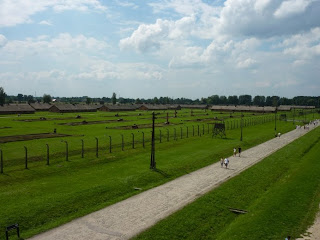If Auschwitz were not chilling enough, Birkenau was overwhelming. The Germans were able to destroy much of it as they withdrew in 1944, so there are few exhibits. It is the scale of the thing--a square mile of barracks, the railroad, the gas chambers, the crematoria--that is staggering.
 |
A USAAF photo of the Auschwitz complex
in May, 1944; Auschwitz II, Birkenau, is
the huge installation at the top
|
 |
The scale is staggering, even with most of the buildings
destroyed; this is half the complex
|
 |
The other half
|
 |
Auschwitz III, a chemical plant and other industry, in the
distance, under the stacks
|
 |
The railroad tracks led virtually to the gas chambers
|
 |
One of the small railway cars, packing in 100 or so men,
women, and children, and their belongings, instruments
of murder themselves; in April/May of 1944, the
Germans occupied Hungary and forced its hitherto
reluctant government to allow deportation of nearly
500,000 Hungarian Jews, nearly all of whom died at
Auschwitz or Mauthausen, in Austria; Greek Jews
were forced to pay their own railway fares
|
 |
Before the "selection," women and children on one side, men
on the other; typically, about 80% went directly to the gas
chambers
|
 |
Remains of gas chamber and crematorium 3
|
 |
As it appeared in 1944
|
 |
At the Auschwitz/Birkenau Memorial
|










No comments:
Post a Comment